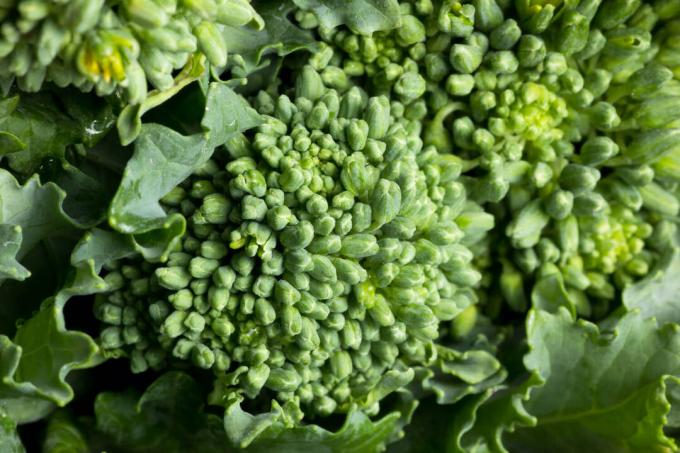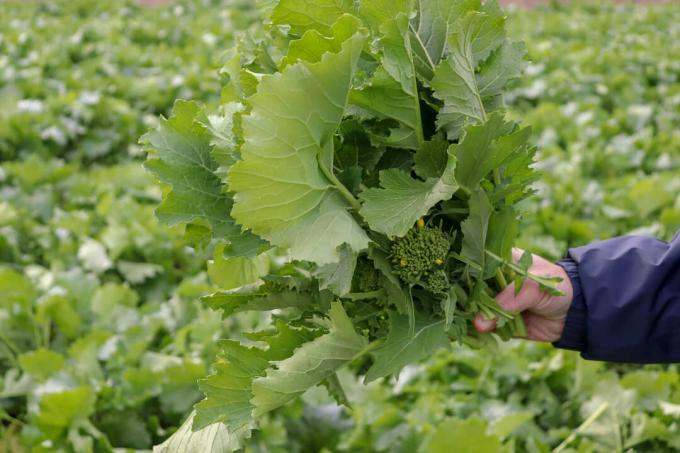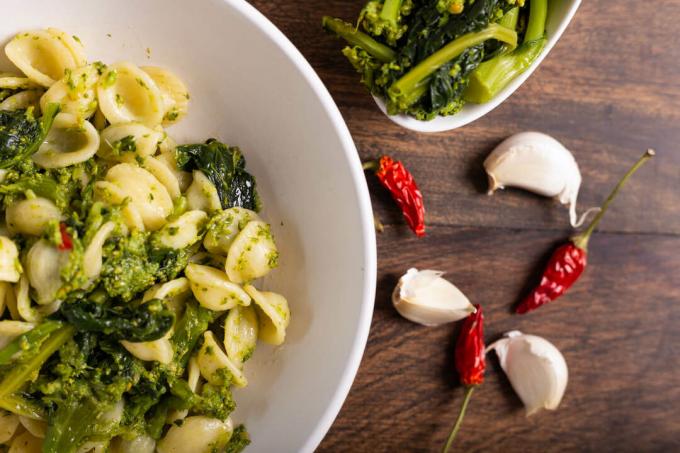The Italian stem cabbage is a fairly unknown, but fast-growing vegetable. We give tips on how to grow and use Cima di rapa.

Cima or Cime di rapa (Brassica rapa var. cymosa) is called stem cabbage in German. It is a type of cabbage from the Brassicaceae family, which is particularly valued in Italy, Spain and Portugal. This has been going on for several years broccoli (Brassica oleracea var. italica) reminiscent vegetables are grown more and more often in the USA and Germany.
contents
- Cime di rapa: origin and characteristics
- The best varieties
- Growing cime di rapa: sowing and planting
- Proper care
- Harvest and storage of the cabbage
- Prepare and use the cime di rapa
Cime di rapa: origin and characteristics
The stem cabbage originally comes from southern Italy, probably from the regions of Apulia and Campania. The stem cabbage, also known as broccoletto, Rapini, Rappa, Raab, Grelo or asparagus broccoli, is considered a further development of field cabbage (
Brassica campestris), which is widespread as a weed growing wild. As an annual plant, Cima di rapa grows to a height of 50 to 80 cm in a short time. The grass-green, strong stems are covered with leaves and numerous small inflorescences that are reminiscent of broccoli. The stem cabbage blooms about 40 to 80 days after sowing and then opens the bright yellow, four-fold flowers.
The best varieties
Stalk cabbage seeds are rarely available in gardening shops. With a little luck, however, you will find yourself in specialty nurseries like Deaflora or at Italian seed dealers like the company Franchi find it. We present the best varieties of Cima di rapa.
- ‘Cinquantina‘: Medium early ripening variety that can be harvested after 50 days. It has a good aroma and has large leaves and inflorescences.
- ‘Grande Fasano‘: A cabbage variety that grows to around 50 cm in height and is ready for harvest after 40 days and is therefore one of the early varieties. The variety produces particularly large inflorescences.
- ‘Massafrese‘: Italian variety with thick stems and a high percentage of leaves. It can be harvested after 50 days before the flowers have fully developed.
- ‘Novantina‘: Italian stalk cabbage with a medium-early ripening time and a very intense taste. It can be harvested after 45-50 days (even if “Novantina” means ninety).
- ‘Quarantina‘: Easy to care for, large-leaved variety that is harvested after 35-40 days as it flowers very early. Several side buds with flowers can be harvested per plant. Plants of this variety reach a height of approx. 40 cm.
- ‘Riccia San Marzano‘: Stalk cabbage with medium ripeness that can be harvested after around 45 days. It forms curled leaves and is an attractive vegetable in the bed.
- ‘Sessantina‘: Medium-late variety with a rather thick trunk and a slightly bitter taste. It is one of the medium to late ripening varieties and is harvested after about 60 days.

Growing cime di rapa: sowing and planting
Since the delicate stems and flowers of the Cima di rapa quickly become tough and hard in the heat, it is worth growing stem cabbage only in spring and late summer to autumn. The optimal location for sowing the stem cabbage is on nutrient-rich soils in sunny to partially shaded locations. Since the seedlings develop extremely quickly, they are sown directly on the spot. The planting distance is approx. 10 to 20 cm and 40 cm between rows. The seeds of Cima di rapa should be grown between April and May or August to September to be sown about 2 cm deep into the ground. At temperatures above 15 ° C, the stem kale usually germinates after 7 to 10 days. You can also grow the broccoletto in a pot or a balcony box. A high quality potting soil like ours Plantura organic tomato & vegetable soil is ideal for growing Cima di rapa. It is pre-fertilized and thus provides the fast-growing cabbage with all the essential nutrients right from the start.
Proper care
Stalk cabbage grows quickly and, depending on the variety, is ready to be harvested after five to eight weeks. Removing unwanted weeds is one of the most important maintenance measures between sowing and harvesting. A hoe can be used to loosen the soil and remove the weeds once or twice during the growth phase. Depending on the weather, the stem cabbage needs additional irrigation despite its origin from the Mediterranean region. Because the soil moisture accelerates growth, promotes flower formation and reduces the premature lignification of the shoots.
Typical diseases and pests: Cime di rapa is generally considered to be more robust compared to other types of cabbage. However, it can also come from typical cabbage pests like Cabbage fly (Delia), Cabbage white butterfly (Pieris) and Earth fleas(Psylliodes) become infested. Is the soil with the mushroom the Carbonic hernia(Plasmodiophora brassicae), the roots of Cime di rapa can also get sick from it. Stalk cabbage should therefore only be grown at the same location every 4 - 5 years. A balanced one Mixed culture with other species can deter various pests.

Harvest and storage of the cabbage
Stalk cabbage is harvested whole just before the flower buds open, as the stems are particularly juicy at this time. Everything on the plant is used: the mild flowers, the crunchy stems and the leaves, which have a strong taste of cabbage. Depending on the time of planting and the variety, you can harvest from June or between September and December. Cime di rapa can be kept fresh for about a week in a cool, dark and moist wrap or in the refrigerator. You should only harvest as much as you can use directly. Alternatively, the leaves and inflorescences of stem cabbage in particular can be frozen and kept for many months. The stem kale keeps well outdoors even at the beginning of winter and can withstand light night frosts without any problems.
Prepare and use the cime di rapa
Cime di rapa is rich in vitamins, minerals and secondary plant substances such as the antibacterial mustard oils. It has a mild to intensely aromatic, partly slightly bitter taste, depending on the variety, and is very low in calories at around 30 kcal per 100 g. The taste contrasts well with hearty pasta or grilled meat, which is why the stem cabbage is often served in recipes as a side dish or ingredient in sauces. The mild flowers soften the strong cabbage taste of the leaves and should therefore be added to the process. The stem cabbage should only be blanched or steamed briefly in order to preserve the health-promoting ingredients. Stalk cabbage can also be served raw with a salad, similar to arugula (Eruca sativa), to process. Briefly blanched and then seared for a minute, it can be enjoyed as a lukewarm salad with anchovy vinaigrette. Alternatively, after blanching, it can be served with a little salt, balsamic vinegar and lots of olive oil as an accompaniment to various dishes. Tasty pesto and spreads can also be made from stem cabbage.

Is Stalk Cabbage Healthy? In addition to potassium, Cime di rapa mainly contains calcium, folic acid, various B vitamins and a high content of vitamin C. The low calorie content and antimicrobial mustard oils also make a significant contribution to the fact that stem cabbage is considered a healthy vegetable.
There is a great variety of the popular winter vegetable, cabbage. In this article we have the most important ones for you Types and types of cabbage summarized.


